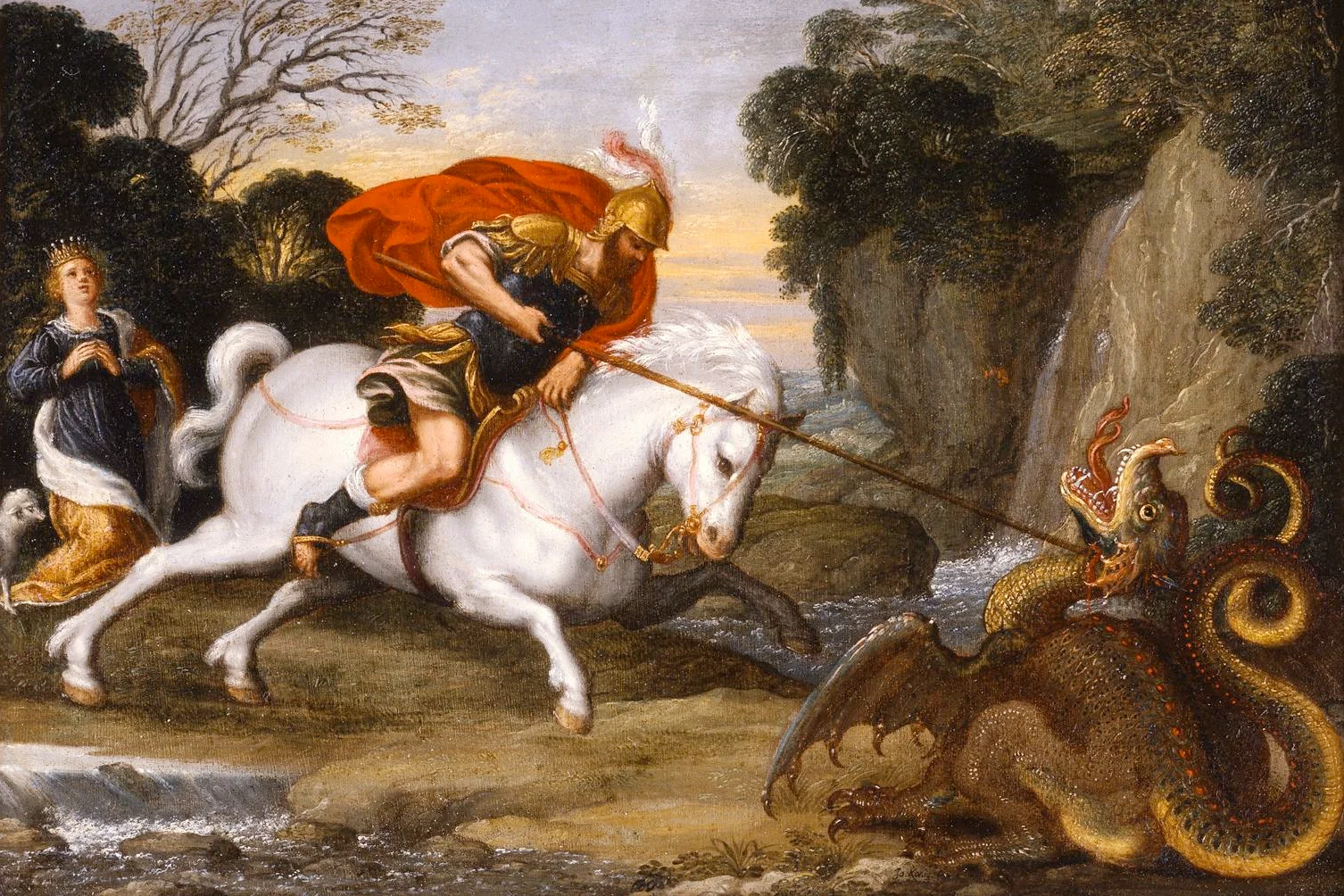Hey there, curious minds! Let’s dive into the epic tale of Saint George, the brave Roman soldier who’s famous for taking on a mighty dragon. This story has been around for ages, and folks have been wondering for centuries if it really happened. So, grab a comfy seat and get ready for a thrilling exploration into the truth behind the legend of Saint George and the dragon!
Did St. George Really Fight a Dragon?
Okay, so you’ve heard the stories about St. George, right? The brave knight who faced down a terrifying dragon? It’s a tale that’s been around for ages, told and retold across countless generations. But how much of it is actually, you know, true?
The St. George and the dragon story emerged around the 11th century in Georgia (the country, not the U.S. state!) and gained popularity during the Crusades. Knights back then saw St. George as this awesome symbol of courage and faith, someone to look up to when the going got tough.
Now, historians generally agree that St. George was a real person. The dragon part? That’s where things get a bit fuzzy. Some experts think the dragon is a metaphor, a symbol of early Christianity winning over older, pagan beliefs. Others say it’s probably based on even older myths and legends, the kind of stories people have always shared.
Think about it: the story works on a deeper level, doesn’t it? It’s about good versus evil, about facing your fears and fighting for what’s right. That’s why people have connected with this story for centuries. It’s like Star Wars or superhero movies today – we love seeing the hero conquer the monster!
Over the years, the story of Saint George and the dragon has popped up everywhere: paintings, sculptures, books, even music. There’s something about it that just captures the imagination.
And get this – there’s a place in England, Uffington, where they have this giant white horse carved into the side of a hill. Locals will tell you it’s St. George’s horse, forever commemorated! They even say the ground where the dragon supposedly died is barren, stained by its blood. Pretty wild, huh?
So, did St. George actually slay a fire-breathing dragon? We might never know for sure. But one thing’s certain: the story has become a legend, a symbol of hope and bravery that continues to inspire us today.
Who Was Saint George and Why Is He Famous?
Saint George, often depicted on horseback slaying a fearsome dragon, is a prominent figure in Christian history. But who was he, beyond the legendary tales?
Saint George was not merely a fictional hero. He was a real person, a Roman soldier who lived during the Roman Empire. However, his open practice of Christianity put him at odds with the reigning Emperor Diocletian, who had outlawed the religion. Despite the risks, George remained steadfast in his faith, ultimately suffering martyrdom for his beliefs.
The iconic dragon in the legend, while captivating, is likely symbolic rather than literal. It embodies the challenges and evils that Saint George confronted, both personally and in defense of his faith. The dragon represents fear, persecution, and the forces opposing Christianity.
Saint George’s unwavering faith and courage in the face of persecution turned him into a symbol of bravery and sacrifice. He became the patron saint of England, Georgia, and several other regions, revered as a protector in times of need. His story transcends time, serving as an inspiration to stand strong in one’s convictions, even when facing seemingly insurmountable obstacles.
Here’s why Saint George remains a figure of enduring fascination:
- Saint George: Embodiment of Courage and Sacrifice in Christian Legend
- Patron Saint of England, Georgia, and a Revered Saint in Christendom
- Legendary Dragon Slayer, Symbolizing the Triumph of Good Over Evil
- Early Christian Martyr and Model of Unwavering Faith
Did Saint George Really Slay a Dragon? Exploring the Historical Evidence
The legend of Saint George and his epic battle with the dragon has captivated imaginations for centuries. But did this dragon slaying actually happen?
Unfortunately, concrete historical evidence supporting the dragon aspect of Saint George’s story is lacking. No ancient texts definitively detail such an encounter. Some historians speculate that an ancient myth or legend became interwoven with Saint George’s narrative over time, leading to the dragon’s inclusion.
Others propose that the dragon, rather than a literal creature, serves as a powerful metaphor for the challenges Saint George faced. This interpretation views the dragon as a representation of the persecution endured by early Christians or the temptations they resisted.
Despite the lack of concrete evidence, the legend’s enduring power lies in its symbolism. It portrays the timeless battle between good and evil, urging individuals to stand firm in their beliefs even when facing overwhelming odds. This message continues to resonate with audiences, solidifying the legend’s status as a testament to courage and faith.
The legend’s impact is undeniable. Saint George evolved into a global icon, his story woven into art, literature, and folklore worldwide. From artistic masterpieces to countless retellings, his story’s enduring appeal speaks to the human spirit’s potential for courage, compassion, and the enduring belief in good’s power to overcome even the most daunting challenges.
Here are some key takeaways from exploring the historical evidence:
- Line 1: Saint George, a Roman soldier, became a legendary dragon slayer after killing a beast terrorizing a Libyan city.
- Line 2: Despite historical uncertainty, the dragon-slaying tale symbolizes George’s triumph over evil and persecution.
- Line 3: Saint George is revered as the patron saint of England, Portugal, and other countries due to his heroism and unwavering faith.
- Line 4: The dragon-slaying legend has been depicted in art, literature, and folklore for centuries, solidifying George’s status as a cultural icon.
So, did Saint George really slay a dragon? The historical jury’s still out on that one. But what we do know is this: the legend of Saint George continues to inspire us, reminding us that even in the face of overwhelming darkness, courage and faith can prevail. And that’s a story worth telling, dragon or no dragon.
The Saint George and the Dragon Legend: Symbolism and Interpretations
Discover the legendary tale of a valiant knight killing a dragon in this epic adventure that will keep you on the edge of your seat. The Saint George and the Dragon legend, far from a simple tale of knight versus beast, delves into deeper symbolic meaning.
The story’s core themes resonate through the ages:
- The timeless struggle: At its core, the story showcases the age-old battle between good and evil that we see reflected throughout history and in our own lives.
- A glimmer of hope: The dragon’s taming reminds us that redemption is always possible, even in the darkest of circumstances.
- Cultural impact: From patron saint to artistic inspiration, the legend’s mark on culture is undeniable and far-reaching.
The imagery itself holds profound meaning. Saint George, representing courage and righteousness, faces off against a terrifying dragon, embodying chaos and the unknown. George’s victory extends beyond physical prowess, symbolizing the triumph of good over evil and the forces of darkness.
Intriguingly, rather than slaying the dragon, George often tames it. This act of mercy introduces the concept of redemption, implying that even the most fearsome entities can be transformed. The dragon, symbolic of the untamed wilderness and the challenges of civilization, highlights humanity’s continuous struggle to tame both the external world and our inner nature.
The Saint George and the Dragon legend, transcending a simple tale, explores:
- The triumph of good over evil: George represents the forces of good, and the dragon represents evil.
- The potential for redemption: The dragon, not killed but tamed, symbolizes the possibility of redemption even in the most evil of creatures.
- The struggle between civilization and wilderness: Some interpretations see the story as a representation of the challenges humanity faces in establishing civilization amidst the untamed wilderness.
The legend’s cultural significance is undeniable. Saint George became the patron saint of England and other nations, his story woven into their cultural fabric. From breathtaking paintings to countless literary adaptations, his tale endures, inspiring courage, compassion, and the unwavering belief in good’s ability to overcome even the most daunting challenges.
- Unveiling Bernhard Caesar Einstein’s Scientific Achievements: A Legacy in Engineering - July 15, 2025
- Uncover who is Jerry McSorley: CEO, Family Man, Business Success Story - July 15, 2025
- Discover Bernhard Caesar Einstein’s Scientific Contributions: Unveiling a Legacy Beyond Einstein - July 15, 2025















